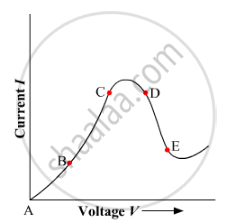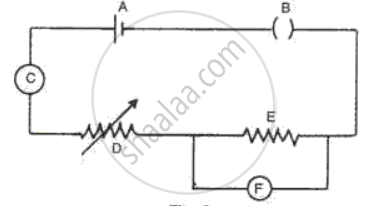Advertisements
Advertisements
प्रश्न
The relationship between the potential difference and the current in a conductor is stated in the form of a law.
1) Name the law.
2) What does the slope of V-I graph for a conductor represent?
3) Name the material used for making the connecting wire.
उत्तर
1) The relationship between the potential difference and the current in a conductor is given by Ohm’s law.
2) The slope of the V–I graph gives the resistance of the conductor.
Slope = `V/I = R`
3) The material used for making connecting wires is copper.
APPEARS IN
संबंधित प्रश्न
Graph showing the variation of current versus voltage for a material Ga As is shown in the figure. Identify the region of
(i) negative resistance
(ii) where Ohm's law is obeyed.

What is an Ohmic resistor?
Name the unit of electrical resistance and give its symbol.
Name the physical quantity whose unit is "ohm".
What is the necessary condition for a conductor to obey Ohm’s law?
A car bulb connected to a 12 volt battery draws 2 A current when glowing. What is the resistance of the filament of the bulb? Will the resistance be more same or less when the bulb is not glowing?
Calculate the current flowing through a wire of resistance 5 Ω connected to a battery of potential difference 3 V.
Fig. represents the circuit used for the verification of Ohm's law. Label the parts from A to F. state the function of each.

Ohm’s law states the relationship between power and voltage.
Obtain the macroscopic form of Ohm’s law from its microscopic form and discuss its limitation.
